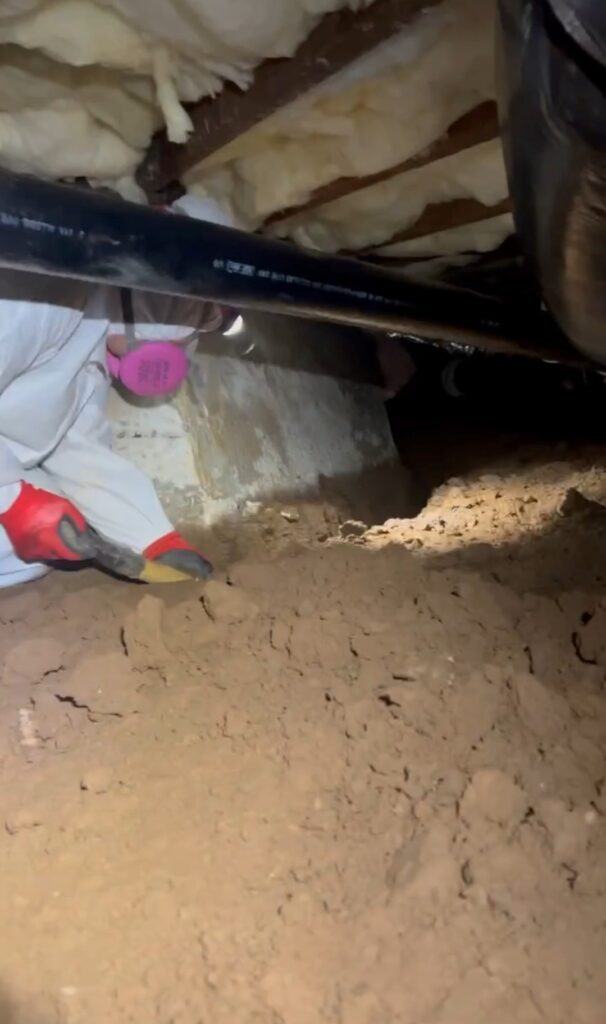A damp crawl space can be more than just a nuisance; it can potentially affect the health and safety of your entire home. But how do you deal with it, and what causes it? In this article, we show you the signs to watch and what to do about moisture under the house in your crawl space.
Causes Crawl Space Moisture
Moisture in the crawl space can come from a variety of sources or issues in your crawl space, including:
Poor Ventilation
Poor ventilation is one of the most common sources of crawl space moisture build-up. We all keep our living spaces well-ventilated to prevent mold and mildew, but few consider the conditions below our feet. Water vapor can accumulate without adequate ventilation in the crawl space. Under the right conditions, it will condense onto the crawl space surfaces where it can cause all sorts of problems.
Water Leaks
Minor and major water leaks can introduce water into the crawl space. A small crack in the plumbing, a crack in your home’s foundation, or even water seeping in from heavy rain are all sources of crawl space moisture.
High Humidity Levels
High humidity levels can cause your crawl space to be damp. Moisture in the crawl space air will condense when it cools. It accumulates in the crawl space, leading to dampness and potentially damaging the wooden floor joists and floorboards.
Poor Drainage
Inadequate drainage, especially after heavy rain, can cause water puddles. Proper drainage systems, including gutters, downspouts, sump pumps, and French drains, are just a few of the strategies you can use to keep water away from your home.
The Dangers of Excess Moisture in Crawl Spaces
Excess moisture in your crawl space isn’t something you should ignore. It can cause various issues, including structural problems and potential health hazards.
Structural Damage
Too much moisture will lead to significant structural damage. Water seeps into the wood and other building materials, causing rot and decay. Over time, this can weaken the integrity of your home’s structure, including important structures like the floors and walls.
Mold Growth
A damp crawl space is a perfect breeding ground for mold and mildew, which thrive in moist dark environments like a crawl space. Their spores can spread throughout your home via the HVAC system. This can not only damage your home but also affect the indoor air quality.
Pest Infestations
Moist environments attract various pests, including insects, rodents, and even termites. If left unchecked, these pests can cause significant damage to your home and can also be a potential health risk.
Health Hazards
Finally, the presence of moisture can also lead to health issues for those living in the home. Mold spores and dust mites, which thrive in damp environments, can cause allergies and respiratory problems.
Signs of Moisture in Crawl Spaces
Knowing how to spot the signs of a damp crawl space can help you address the problem before it becomes a significant issue. Check for these common signs:
Musty Odors
A musty, damp smell is often the first sign of excess moisture in your crawl space. This odor can even permeate into your living areas, so don’t ignore it.
Visible Mold Growth
Visible mold growth in the crawl space clearly indicates moisture problems. Mold can appear in various colors and forms, but it’s time to take action if you see it in your crawl space.
Buckling Floors
If your floors are buckling or feel spongy underfoot, this could indicate moisture issues in the crawl space. Excess water can cause the wooden structures to warp, leading to noticeable changes in your flooring.
High Energy Bills
Surprisingly, a damp crawl space can also lead to higher energy bills. This is because damp air that rises up through the living space needs more energy to heat or cool, which puts extra strain on your HVAC system.
Checking your crawl space every 6 months is highly recommended. This will give you plenty of time to detect problems and act on them before they become expensive issues.
How to Deal with Moisture in Crawl Spaces
If you’ve discovered moisture in your crawl space, don’t panic. You have several effective methods you can call on to address the issue and prevent it from recurring.
Install a Vapor Barrier
A vapor barrier, which is a plastic sheet installed over the crawl space floor, is one of the best ways to keep moisture out. This plastic barrier prevents ground moisture from entering and pooling in the crawl space. Check out below for more information about installing a crawl space barrier, and where to go for a professional installation.
Improve Ventilation
Improving ventilation is another easy method for keeping your crawl space dry. Consider installing crawl space vents or using fans to increase air circulation and decrease humidity levels.
We recommend a professional appraisal of your crawl space before installing vents or fans. Too much or too little ventilation can cause more problems than it solves. Expert advice will ensure you get just the right amount of airflow.
Fix Water Leaks
Any existing water leaks should be fixed right away. This could involve plumbing repairs, sealing foundation cracks, or fixing the roof to prevent water from seeping into the crawl space.
Ensure Proper Drainage
Proper drainage is another great way to keep moisture away from underneath your home. Drainage could include cleaning out your gutters and downspouts, adding more downspouts, grading the yard away from your home, or installing a sump pump to remove any standing water.
Installing a Vapor Barrier
A vapor barrier is a highly effective way to control moisture in your crawl space. Here’s how to get one installed:
Choosing the Right Material
Start by choosing the right material for your vapor barrier. Polyethylene plastic sheeting, which is durable and water-resistant, is commonly used. The thickness you choose depends on the conditions in your crawl space, but a thicker barrier generally provides better protection.
Preparing the Crawl Space
Before you install the barrier, the crawl space should be thoroughly cleaned and any standing water or debris removed. It’s also a good idea to fix any existing water leaks at this stage.
Installing the Barrier
Cover the crawl space floor with plastic sheeting to install the barrier, ensuring it overlaps at the seams. The barrier should extend the crawl space walls and be securely fastened. Remember, the goal is to create a continuous barrier that prevents ground moisture from entering the crawl space.
Maintaining the Barrier
Over time, the vapor barrier may tear or get damaged, allowing moisture to seep in. Regular crawl space inspections can help identify any damage early and ensure the barrier remains effective.
The dark, cramped conditions of a crawl space mean adding a vapor barrier is not the easiest of home improvements. Fortunately, professional vapor barrier installation services near you can do the job quickly and ensure it’s done correctly.
Don’t Ignore Crawl Space Moisture
Whether it’s installing a vapor barrier, improving ventilation, fixing water leaks, or ensuring proper drainage, each step plays a critical role in keeping your crawl space moisture-free. And you don’t have to do it alone.
For professional help, don’t hesitate to contact Attic Pros for professional crawl space encapsulation near you. Our experienced team can help diagnose your crawl space issues, recommend the best solutions, and even perform a free crawl space appraisal to ensure your home stays dry and safe.

